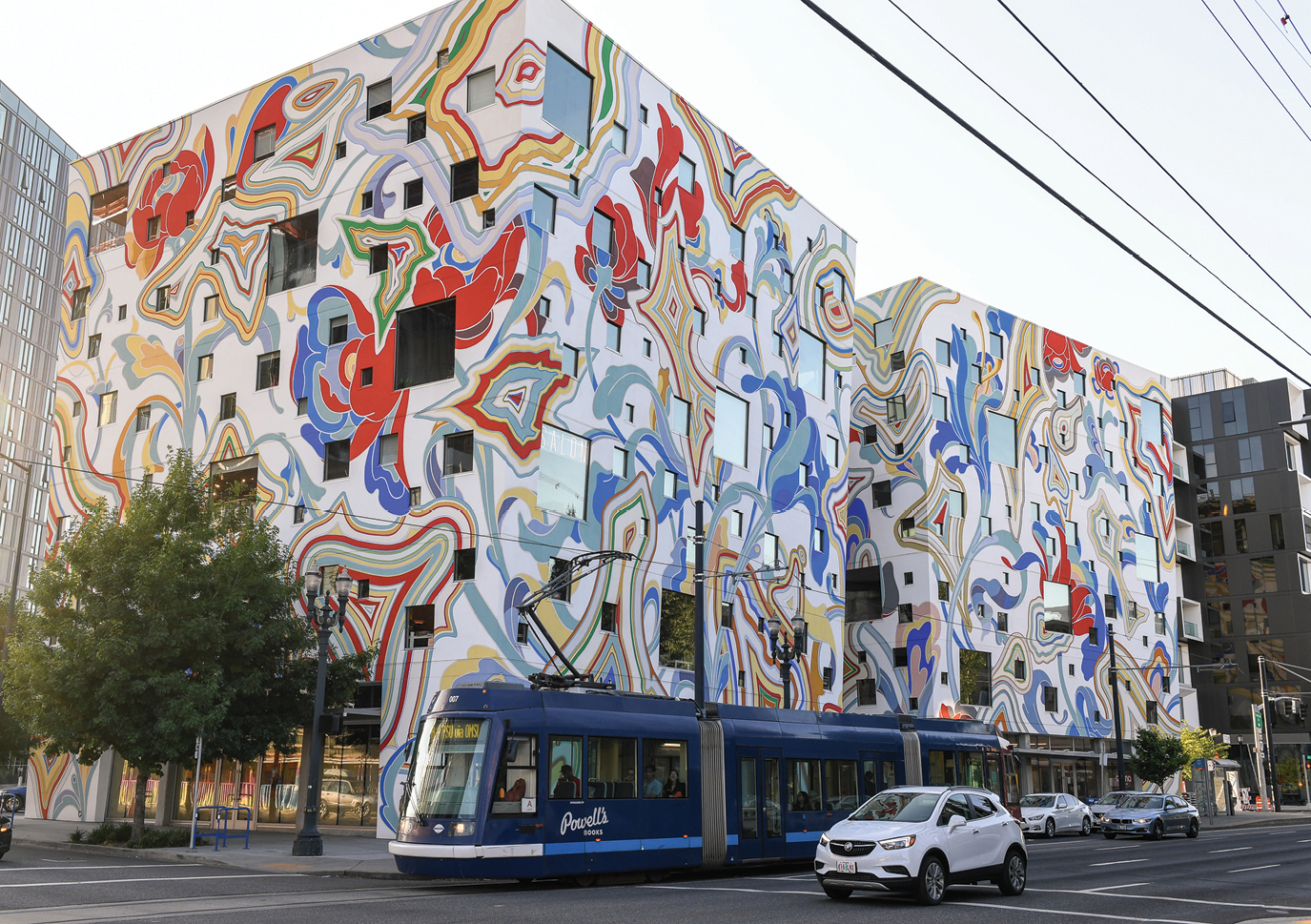What are the attributes of a smart city? Sensors, cameras, 5G and wifi? A proper blend of walkability, transit and traffic lights that know when to change? Super-fast connections combined with a conscious effort to slow down? Or is there something more?
In “New Industrial Urbanism: Designing Places for Production,” published by Routledge this spring, MIT Professor Eran Ben-Joseph and co-author Tali Hatuka posit that it’s time for smart cities to embrace industry as a key element. Their socio-spatial New Industrial Urbanism concept “suggests shaping cities with a renewed understanding that an urban location and setting give industry a competitive advantage,” stemming from access to a skilled labor force, universities, and the effects of clustering industry firms together.” By special arrangement with MIT and the publisher, here is an adapted excerpt from their new book, illustrated by images from places the authors highlight.
— Adam Bruns, Managing Editor
Over the past century, countries around the world have experienced rapid urbanization around their edges and deindustrialization in their cores. Cities worldwide will have to continue adjusting to climate change, large-scale migration, shifts in family structure, rapid technological changes, public health crises, and other powerful social and political forces. As they do so, they will have to address acute social needs, identify the underlying trends, and reassess patterns and systemic features of the built environment. Adjustments also bring new economic opportunities made possible by advanced technological changes, and social challenges as cities become ethnically diverse, persistently unequal, with aging infrastructure. In responding to these challenges, regulatory flexibility and physical planning are key mechanisms. Through the design of physical spaces, as well as the policies and technologies that shape how those spaces are used, cities will be able to sustain and enhance the quality of the human environment including places of production.
Some cities around the world are experimenting with flexible regulatory and participatory frameworks in order to achieve more integrated city-industry areas that will accommodate their changing needs and future uses. At the level of the design and architecture, these districts also allow experimentation with new typologies of blended-style buildings.
Cities should see industrial planning as a purposeful intervention in the public arena aimed at improving the quality of life in place and spaces. In doing so, the economy, society and the built environment must be addressed simultaneously, and without prioritizing one over another. This approach is based on a premise that the industrial sector is dependent on society and vice versa. This codependency should remind us that each plan for an industrial area or site is a complex, sociopolitical project that can, should, and often will shape the development of the future of a city. Accordingly, what is needed for industrial development to be extended is a concrete vision that addresses the social needs and the physical environment.
 “Just as we often do with housing policies, it is essential that we design strategic land-use mechanisms that protect and enhance existing industrial uses within our cities.”
“Just as we often do with housing policies, it is essential that we design strategic land-use mechanisms that protect and enhance existing industrial uses within our cities.”
— “New Industrial Urbanism” Co-author Eran Ben-Joseph, Class of 1922 Professor of Landscape Architecture and Urban Planning at MIT
Visioning must not neglect education about manufacturing. Education is necessary if we are to dispel lingering misconceptions that industry is always unsafe and polluting, and manufacturing should be presented as an appropriate and even desirable activity within the city. When industrial processes were most noxious, factories moved out of the city and into windowless big-box structures. The animosity was mutual: Manufacturers were just as content to exclude the public as the public was to banish factories from the city.
New Industrial Urbanism is both a conceptual and methodological spatial challenge that demands careful reflection as to how we perceive and develop our cities and regions. It is only by systematically approaching the challenge of encouraging manufacturing and supporting its development, as well as by unifying planning with policy, that we will be able to develop resilient future cities.
Regrettably, most industrial place-making today stands in poor relationship to civic processes and good design. It has often been shunted off as a bureaucratic task of rule writing, standards formation and code enforcement. Such roles rob the urban planning profession of its central goal: to foster democratic civic processes and outcomes whereby communities retain their local character, make the most of existing conditions of the built and natural environment, and create developments that are sensitive to their immediate surroundings.
This attitude must be altered if industry is to be welcomed back, and reassume its role as a good, productive urban citizen. Transparency about the business and practice of industry and a clear, New Industrial Urbanism approach by planners and policymakers would enhance the marketability of our cities and restore industrial pride to all.
Four Concepts for the Future
New Industrial Urbanism is a socio-spatial concept which views manufacturing as part of city life. New Industrial Urbanism aims to shape a new approach to industrial planning through a renewed understanding that urban locations carry a competitive advantage due to access to skilled labor, educational institutions (centers of research and experimentation), and customers. New Industrial Urbanism emphasizes the local economy and seeks to impact the social sphere by empowering small and medium-sized firms and individual entrepreneurs, as a means to buttress localism. Its goal is to adapt cities and prepare societies for the future world of work.

Launched in 2013 by two former Nike employees, the Wildfang tom-boy chic boutique is part of the diverse mix of businesses in the Central Eastside of Portland, Oregon, a district aided by creative zoning and land use strategies and now home to more than 1,110 businesses and 17,000 jobs.
Photos courtesy of Travel Portland
 New Industrial Urbanism offers a framework that unifies the economic sphere (technological trends and related economic development initiatives), the political-social sphere (policies that support human health, well-being, and growth), and the spatial sphere (physical planning). It is based on four key planning concepts:
New Industrial Urbanism offers a framework that unifies the economic sphere (technological trends and related economic development initiatives), the political-social sphere (policies that support human health, well-being, and growth), and the spatial sphere (physical planning). It is based on four key planning concepts:
Scalar Strategies
Caring for a city’s social needs, planning regulations, and advanced manufacturing requires a different perception of the city. Such a conceptualization situates the city within its broader development by viewing the regional area as an innovation-production ecosystem that cultivates production and livability on a continuum from the local-urban scale to the peripheral-regional expanse. At the regional level, collaborative frameworks evolve over time and employ a range of interaction strategies among industrial actors and institutions. At the level of the urban, establishing a variety of use classifications and designing architectural typologies is key to attracting new manufacturers and ensuring multiple uses of space. Compatible uses need to be coupled with adjustable spatial building configurations to accommodate different scales of industry. Put together, these approaches should offer some flexibility in adapting the urban social and physical context to the dynamic and changing nature of industry.
Integrative Approaches
Bridging the gap between city and industry, with a basic desire to create livable, mixed-use integrated neighborhoods, requires that we also pay attention to concepts that go beyond determining lot sizes, building shapes, or their scales. Some of these concepts may include:
- Connectivity: Encouraging urban design standards and planning policies that support the building of mixed-use industrial neighborhoods connected to the wider region by different types of transportation systems. Supporting and diversifying local economies. Conserving natural resources and farmland. Protecting existing industrial areas from encroachment and promoting urban land zoned for new industry.
- Complexity: Creating symbiotic relationships through the diversification of industrial, business, and housing types. Integrating new forms and typologies of architectural design and sustainable ecological systems.
Character: Supporting outward-looking industrial development and buildings that address the public realm and are reflective of the manufacturing function and identity of the structures and the space they serve. Displaying and blending the distribution system associated with each industry as part of the overall district design.
Coding Complexity
New Industrial Urbanism is about integrating flexible zoning. This step requires the reevaluation of current permitted uses and the consideration of mixing housing with retail, research and development, food production, offices, services, etc., and any other form of production that does not cause negative impacts. It will also require the creation of new regulatory frameworks and zoning categories to adjust for the changing character of manufacturing.
Synchronic Architectural Typologies
Architectural synchronization is a conceptual approach that allows each use to exist and operate in parallel in the same building space. It assures that spaces are used without interfering with each other while utilizing and jointly managing resources. This approach is based on five key principles: optimal management and utilization of land resources; a combination of residence and work, not necessarily of the same users; reducing commuting and dependence on private vehicles; use of built space for 24/7 programmatic functions; and exposure of industry to the public.
These four key concepts — scalar strategies, integrative approaches, coding complexity, and synchronic typologies — are not all-inclusive but are the lenses through which it is suggested the future city should be developed with an aim of supporting and preparing society for enhanced digitization.
Tapping Into a City’s Essence
New Industrial Urbanism argues that urban manufacturing matters. It matters for production and job creation in cities lacking economic opportunity. When manufacturers began to move their operations from the core of the city to the outskirts, they separated factories from the city’s workforce, adding to the spatial mismatch between class and income. Bringing manufacturing jobs back to the center of a city could mitigate the negative effects of industrial sprawl and increase opportunities for diversifying the labor market. In addition, urban manufacturing offers a chance to locate living-wage jobs in close proximity to urban residents.
This potential adjacency will bring measurable environmental benefits associated with shortening commutes and reducing the delivery distances between firms. Proximity can also bolster economic clusters’ strength, due to the positive effects of knowledge spillover and a robust labor market. Promoting urban manufacturing is also a good fiscal policy as cities can generate additional revenue by allowing industrial land to be used more efficiently. Finally, there is a visceral quality to urban manufacturing that is essential to place-making and civic pride in cities. The essence is about connecting to the means of production and tapping into the city’s creative and constructive spirit. By building on industry, cities will be celebrating their past, present, and future as centers of production.
Eran Ben-Joseph is the Class of 1922 Professor of Landscape Architecture and Urban Planning at MIT; Tali Hatuka is a planner, architect, and professor of urban planning and head of the Laboratory of Contemporary Urban Design at Tel Aviv University.

